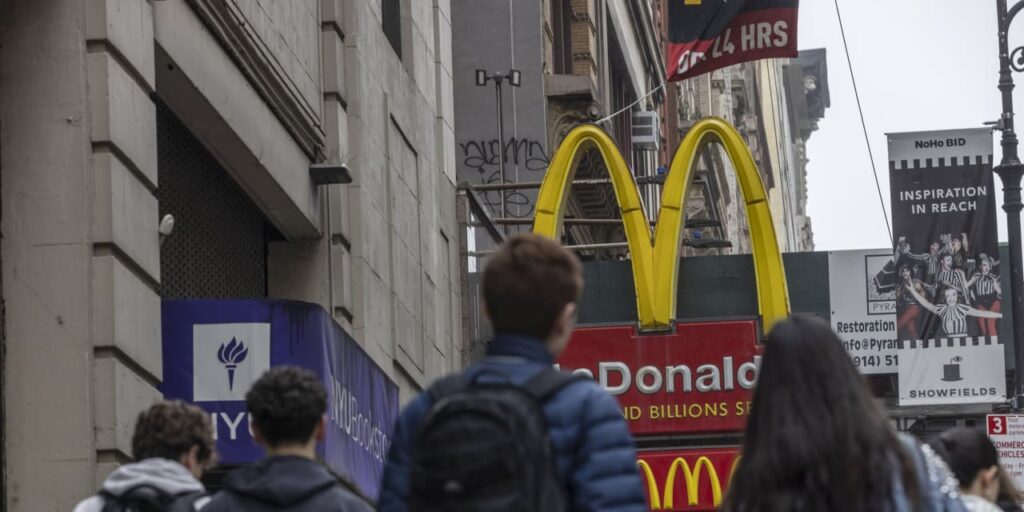McDonald’s franchisees are unhappy with the global fast-food chain over its $5 value menu this summer.
Local businesses set their own menu prices and already offer a number of unique specials, but the chain is now rolling out a new month-long special that will offer a McDouble or McChicken sandwich, small fries, a small soft drink and four Chicken McNuggets, all for $5, starting June 25th.
Franchisees argue the deal will eat into already slim margins: If sold separately, the combined price of the items would exceed $5 in most cities and towns. In one Los Angeles restaurant, for example, the four items would cost about $8.50.
For CEO Chris Kempczinski, the limited-time campaign is aimed at encouraging Americans to dine out again.
Inflation has hit the restaurant industry hard over the past few years, from fine dining to casual dining to fast food, and McDonald’s is certainly not the only national chain advertising discounts.
Advertisement – Scroll to continue
According to Bloomberg, Burger King will be the first to bring back its $5 “Your Way” meal, which will run for several months, ahead of McDonald’s. The chain will also be giving away free Whoppers and drinks for seven consecutive days starting May 28 to celebrate its 70th anniversary.
Wendy’s has had the $5 Biggie Bag Bundle on its menu since 2019. Last week, the chain increased prices on a $3 breakfast bundle that includes small seasoned fries and a muffin sandwich.
Kempczinski wants in on the game because he clearly believes that without a national value deal, McDonald’s could become less competitive.
Advertisement – Scroll to continue
“Our opportunity in the U.S. is to further promote our strong national value proposition and leverage our media scale to drive consumer awareness,” the CEO said on the company’s earnings call in May.
Franchisees voted on the deal several weeks ago, according to The Wall Street Journal, and McDonald’s declined to comment on the outcome.
McDonald’s can suggest pricing strategies, but it generally can’t ask franchisees to lower prices. For national promotions, McDonald’s has to convince local operators to sign on, which it sometimes does by lowering the cost of ingredients, which are often negotiated.
Advertisement – Scroll to continue
McDonald’s franchisees’ profit margins — 10 percent to 15 percent — are too small to allow them to lower prices long-term without corporate support, said the National Association of Owners, an advocacy group for more than 1,000 local business owners.
Of McDonald’s’ approximately 13,500 restaurants in the United States, 95% are franchised.
“A 30 percent discount is not profitable enough for this model to be sustainable and a financial contribution from McDonald’s is required,” NOA wrote in a letter to members.
Other fast-food chains aren’t faring any better. Burger King said its U.S. restaurants will earn an average annual profit of $205,000 in 2023, up nearly 50% from last year. That’s roughly a 12% profit margin, considering the average unit sold last year was $1.7 million. Still, franchisees voted to accept the company’s $5 deal offer, Bloomberg reported.
Advertisement – Scroll to continue
McDonald’s declined to comment on the NOA letter. The company noted that cash flow at its U.S. franchisees has increased by about 50% on average since 2018. The association countered, arguing that cash flow has not kept up with inflation because of rising operating costs.
Franchisees pay royalties of 4% or 5% of sales, depending on when they purchased the restaurant. Restaurants that open after Jan. 1 pay a higher rate.
Advertisement – Scroll to continue
Among the many other expenses are marketing costs and 4% rent, which can range from $85,000 to more than $600,000 a year, according to McDonald’s franchise disclosure documents.
McDonald’s restaurants have an average annual sales of $3.5 million, among the highest in the industry. Yet, after paying regular expenses like merchandise and labor, and paying all fees and rent, franchisees are left with “a business with very little margin,” according to the NOA.
And those margins could shrink, especially if inflation remains high and state minimum wages continue to creep up: In California, for example, hourly wages for fast-food workers rose to $20 from $16 this year.
Meanwhile, the parent company has thrived on franchised restaurants over the past decade: While sales at company-operated restaurants have fallen by half since 2014, sales at franchisees have soared by more than 70%.
McDonald’s revenue from franchisees, which it charges royalties and marketing fees based on sales, has also soared, accounting for 60% of total revenue in the first quarter of this year, up from 33% a decade ago.
The shift in emphasis isn’t surprising, since franchising is far more profitable for McDonald’s than operating its own restaurants: McDonald’s has a 14% operating margin on its company-owned restaurants, but keeps more than 80% of its franchise fees as profit, excluding overhead costs like marketing and technology.
So even though McDonald’s total revenue has fallen over the past decade, its net profits have increased by nearly 60%, meaning the fast-food giant operates with an industry-leading 31% profit margin, much higher than its franchisees.
The question now is, will customers be able to order the new $5 value meal deal, and will McDonald’s offer to cover some of the cost as franchisees hope?
We’ll find out soon. There are only 3 weeks left until June 25th.
Email Evie Liu at evie.liu@barrons.com.


